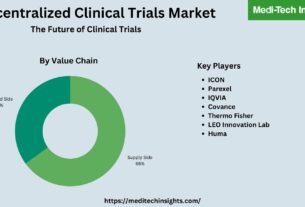The Digital Pathology Market is expected to witness a growth rate of ~10.5% by 2029. The key factors driving the market are the rising incidence of chronic illnesses like cancer, diabetes, and cardiovascular conditions, the expanding utilization of digital pathology in research, the growing integration of digital pathology in drug discovery and precision medicine initiatives, the escalating acceptance of telepathology, and the adoption of digital pathology to streamline laboratory operations and enhance efficiency.
Digital Pathology encompasses the capturing, organization, dissemination, and analysis of pathology data, including slides and information, within a digital framework. Digital slides are generated by scanning glass slides using specialized devices, producing high-resolution digital images that can be accessed and viewed on computer screens or mobile devices.
Download PDF Brochure: https://meditechinsights.com/digital-pathology-market/request-sample/
Rising Adoption of Artificial Intelligence in Digital Pathology Drives the Market
Artificial Intelligence (AI) is revolutionizing pathology by augmenting traditional diagnostic methods, enhancing accuracy, and improving patient outcomes. This technology encompasses machine learning algorithms and deep learning techniques and offers significant potential in various aspects of pathology, including diagnosis, prognosis, and treatment planning. One of the primary applications of AI in pathology is in the interpretation of histopathology slides. Moreover, AI enables the integration of multiple data sources, such as genomic data and clinical information, to provide comprehensive insights into disease pathology. For instance,
- In February 2024, Paige announced a significant expansion of its AppLab marketplace, with the addition of six new digital pathology and AI providers. New applications will be added to the AppLab to provide support for pathology labs worldwide in building deeply integrated and customized AI-enabled workflows
Growing Integration of Digital Pathology in Precision Medicine Accelerates Market Growth
Digital pathology plays a pivotal role in advancing precision medicine approaches by facilitating thorough examination of tissue samples, biomarkers, and genetic information. The integration of digital pathology with electronic health records (EHRs), genomic profiling, and clinical decision support systems offers promising prospects for tailoring treatment strategies according to individual patients’ molecular profiles and disease characteristics.
Rapid Digitalization in Pathology Workflow Propels Market Growth
The increasing digitalization of pathology workflows represents a transformative shift in how pathology laboratories operate, leveraging technology to streamline processes, enhance efficiency, and improve patient care. Digital workflow enables the transmission of images to pathologists, both the speed of diagnosis and the quality of reviews increase. It also offers increased productivity through improved workflow distribution, information management, and integration of data. Operational costs are reduced, because slides and associated paperwork do not have to be moved about, and also delays in diagnosis can be eliminated. In addition, the technology helps compensate for a shrinking pool of pathologists in the workforce because the workload can be distributed remotely to where pathologists are and help enable them to work more efficiently.
Key Constraints/ Challenges
Numerous obstacles hinder the extensive adoption of digital pathology, encompassing the substantial upfront investment needed to establish infrastructure such as slide scanners, image analysis software, and data management systems. Additional challenges entail technological constraints, regulatory hurdles, recurring maintenance expenses, implementation complexities, and reluctance among pathologists to embrace new technologies.
North America Expected to Continue to Hold a Major Share in the Digital Pathology Market
From a geographical perspective, North America holds the major market share of the Digital Pathology Market. This can be mainly attributed to advancement in whole slide imaging (WSI) technology, the rising prevalence of chronic diseases, and the growing integration of digital pathology systems into existing laboratory workflows, in the region.
Competitive Landscape
Some of the key players operating in the market are Paige, Corista, Danaher, Techcyte, and Leica Biosystems among others.
Organic and Inorganic Growth Strategies Adopted by Players to Establish Their Foothold in the Market
Players operating in this market are adopting organic and inorganic growth strategies such as launching new products, acquiring related firms, and entering into mergers & collaborations to garner higher market share. For instance,
- In February 2024, Proscia announced that they had received 510(k) clearance from the United States (U.S.) Food and Drug Administration (FDA) for its Concentriq AP-Dx. The digital pathology solution was cleared for primary diagnosis
- In March 2023, Paige and Leica Biosystems announced an expanded partnership to enhance the use of digital pathology workflows at hospitals and laboratories around the world
Request Sample Report: https://meditechinsights.com/digital-pathology-market/request-sample/
For more granular insights, please get in touch at https://meditechinsights.com/contact-us/
About Medi-Tech Insights
Medi-Tech Insights is a healthcare-focused business research & insights firm. Our clients include Fortune 500 companies, blue-chip investors & hyper-growth start-ups. We have completed 100+ projects in Digital Health, Healthcare IT, Medical Technology, Medical Devices & Pharma Services.
Contact:
Ruta Halde
Associate, Medi-Tech Insights


